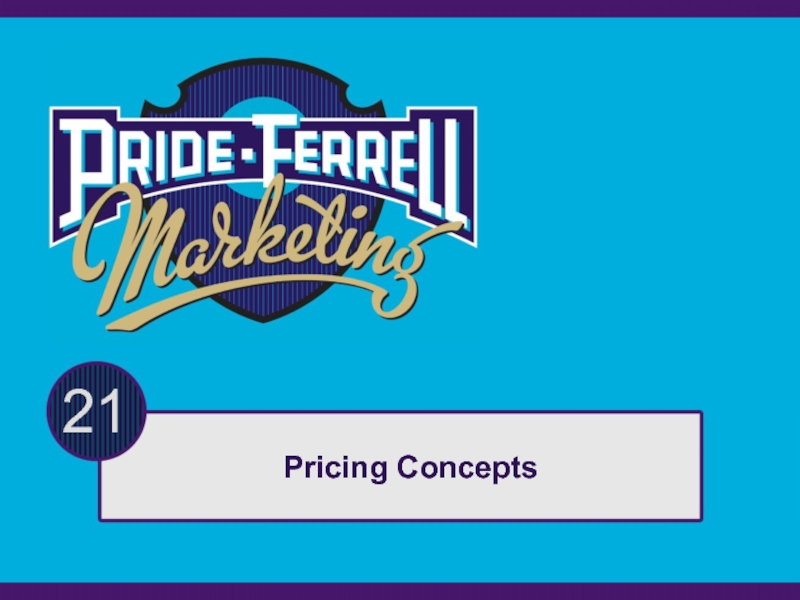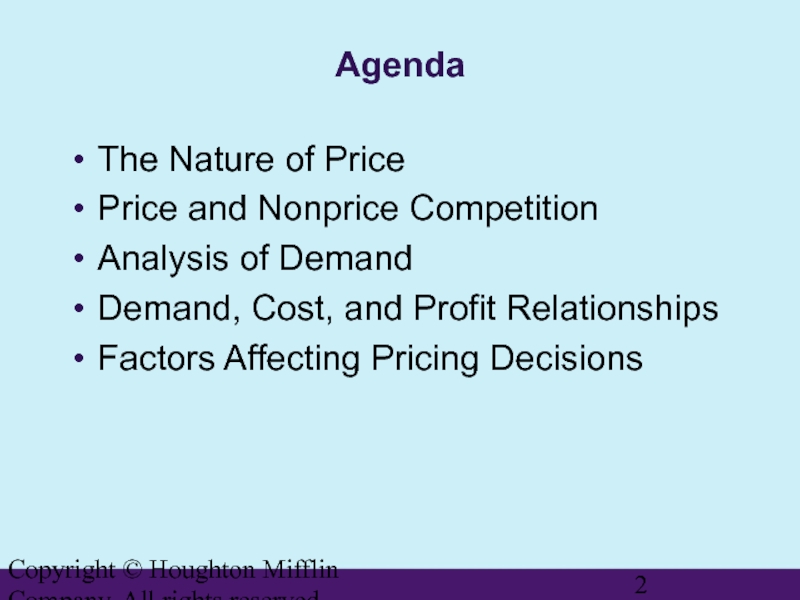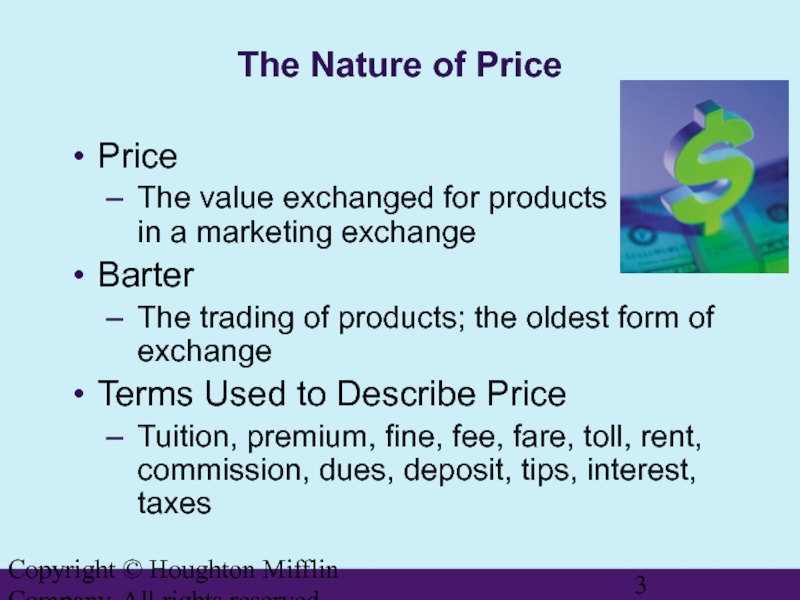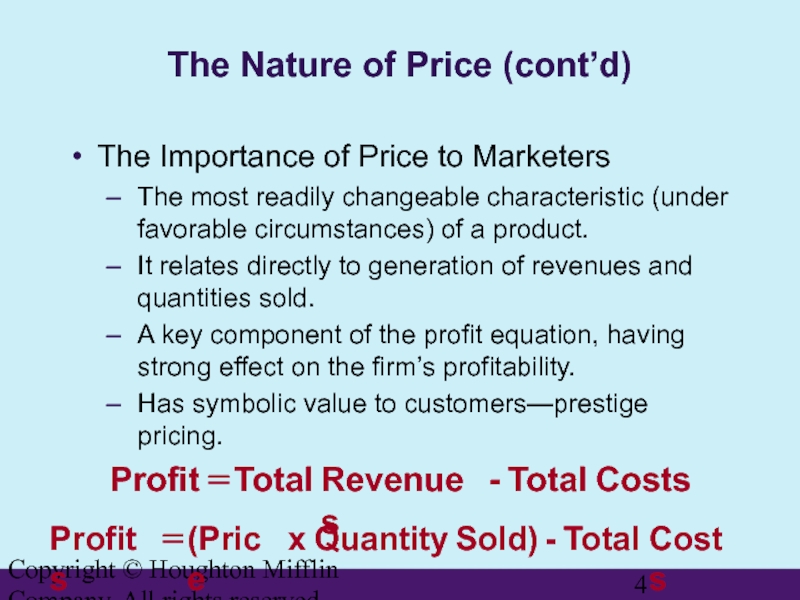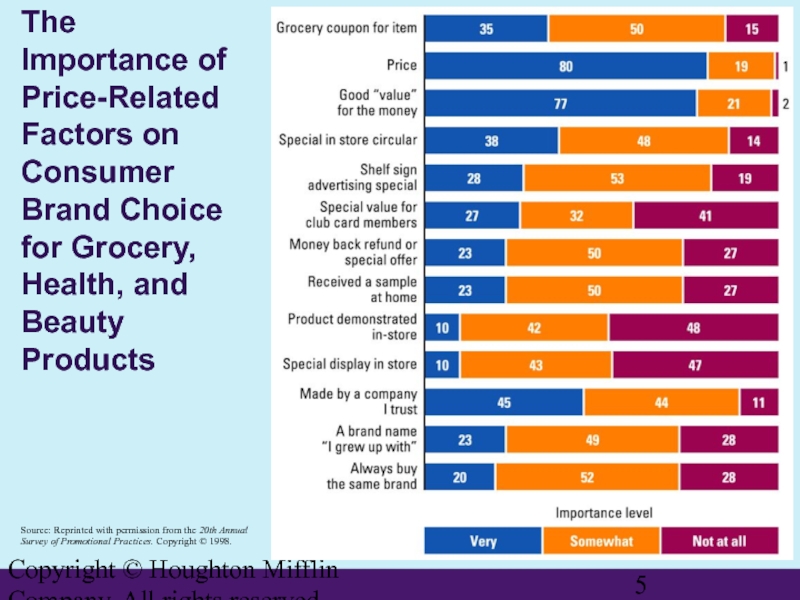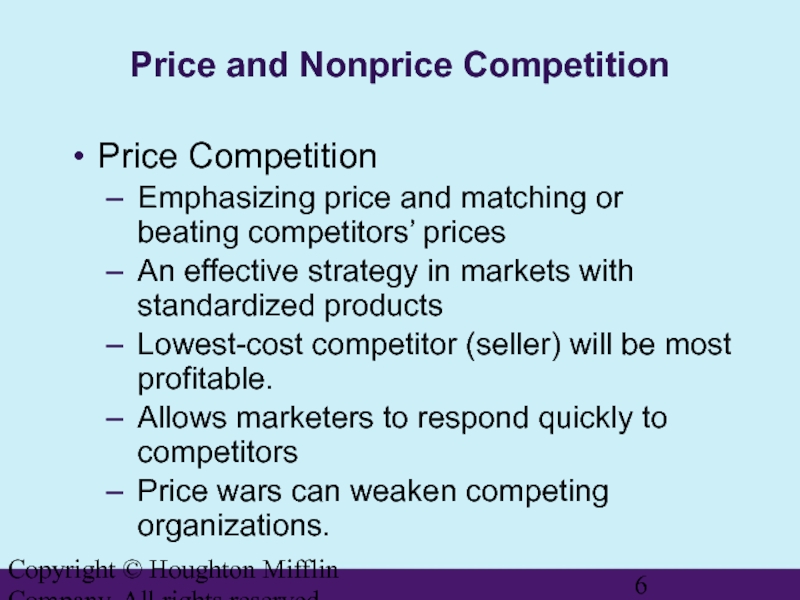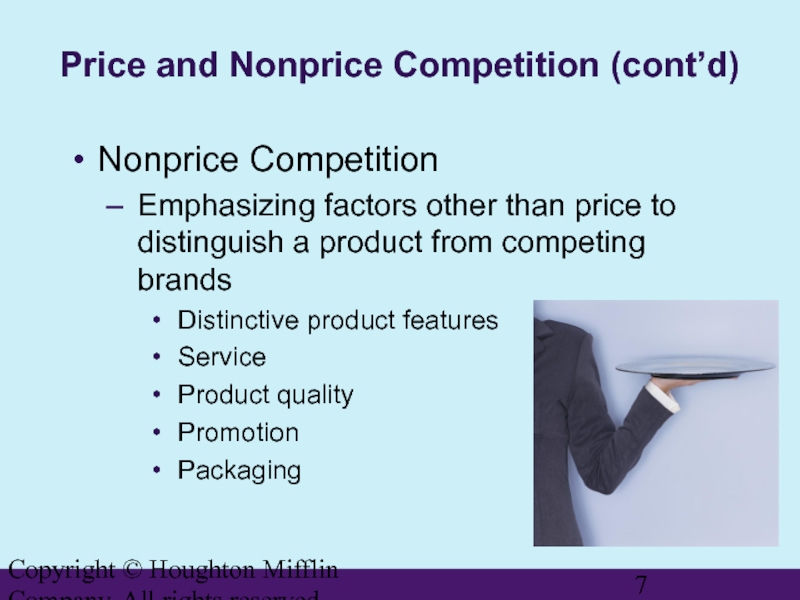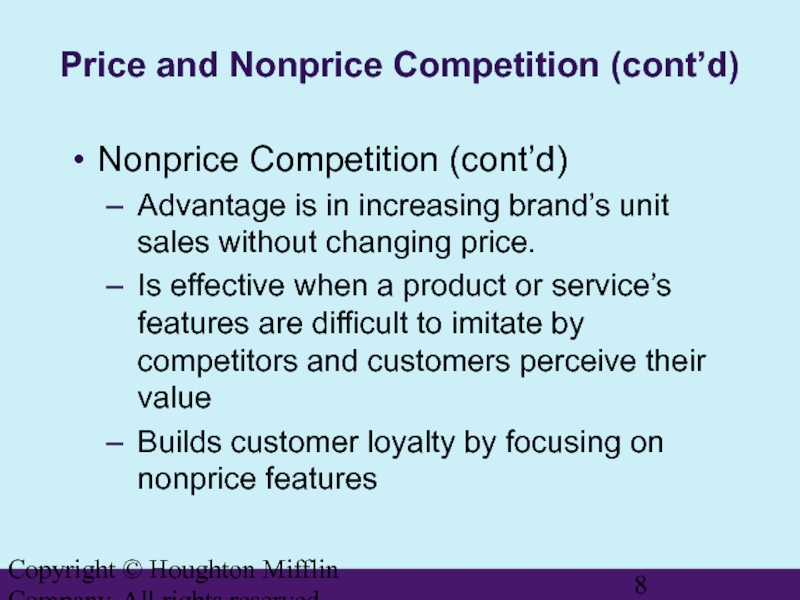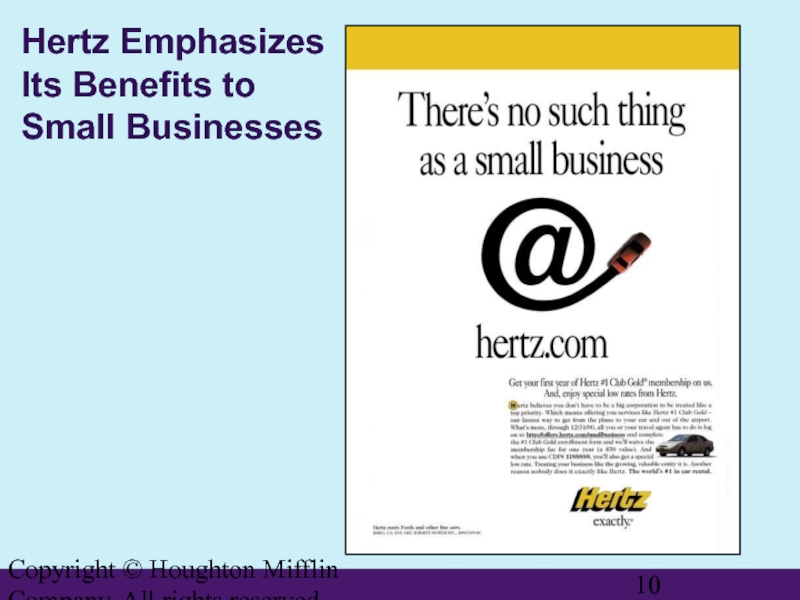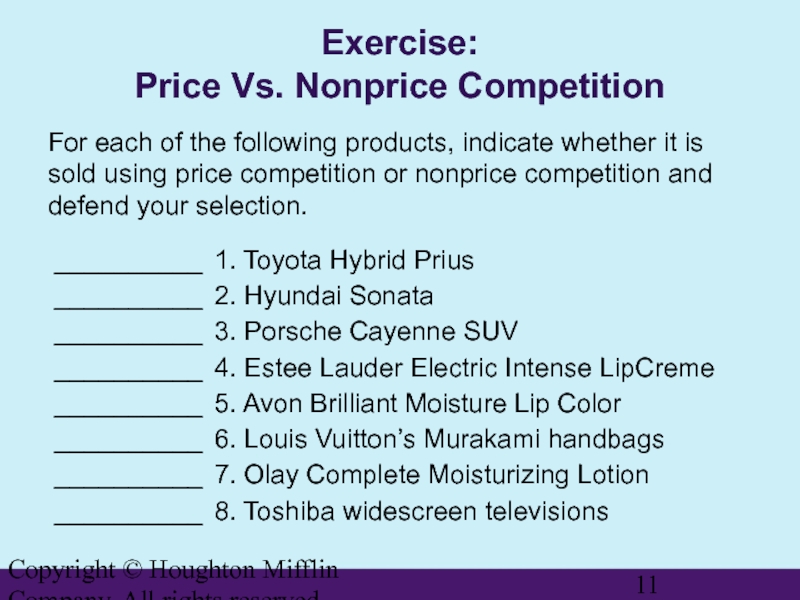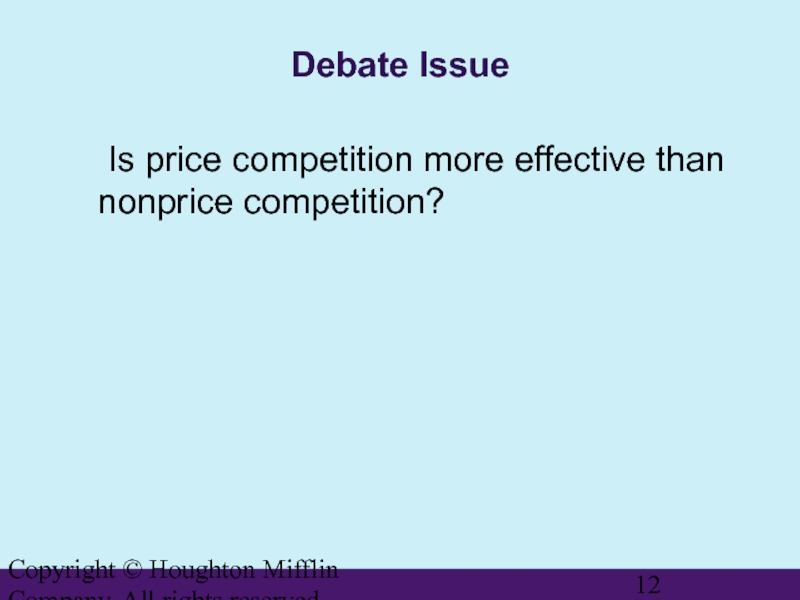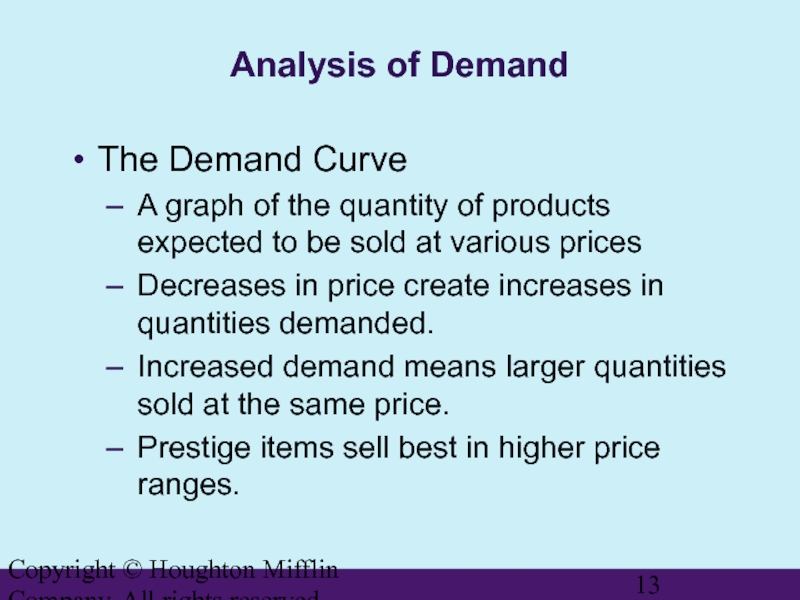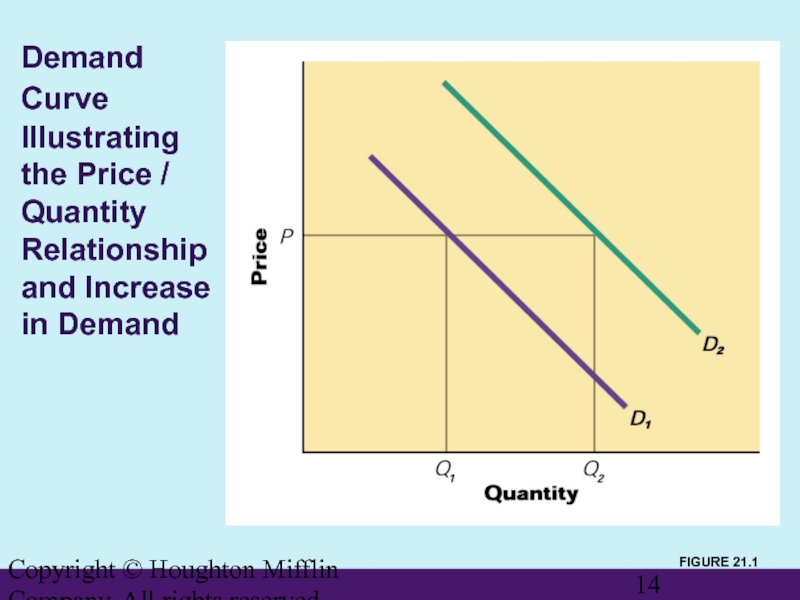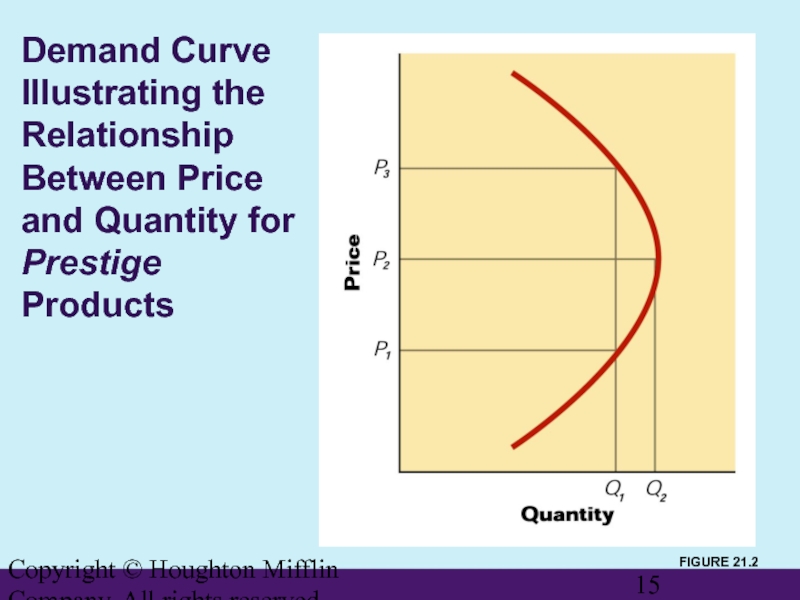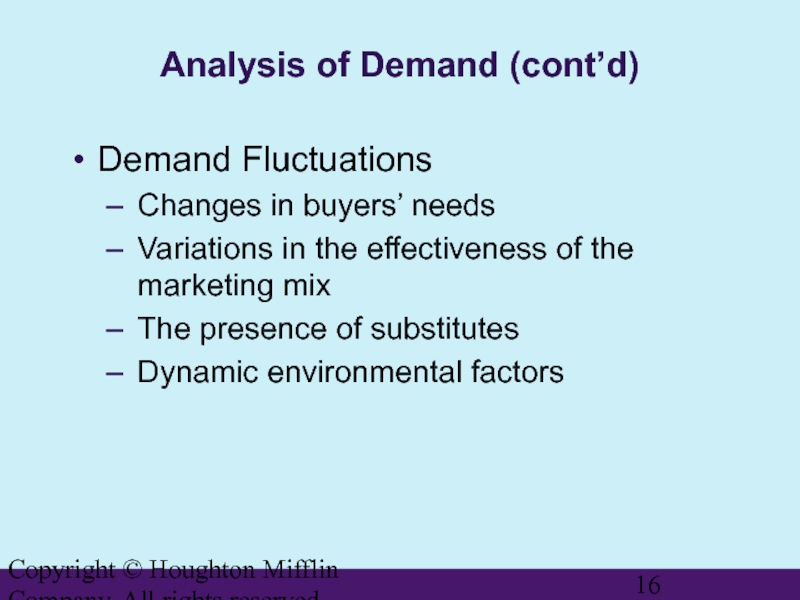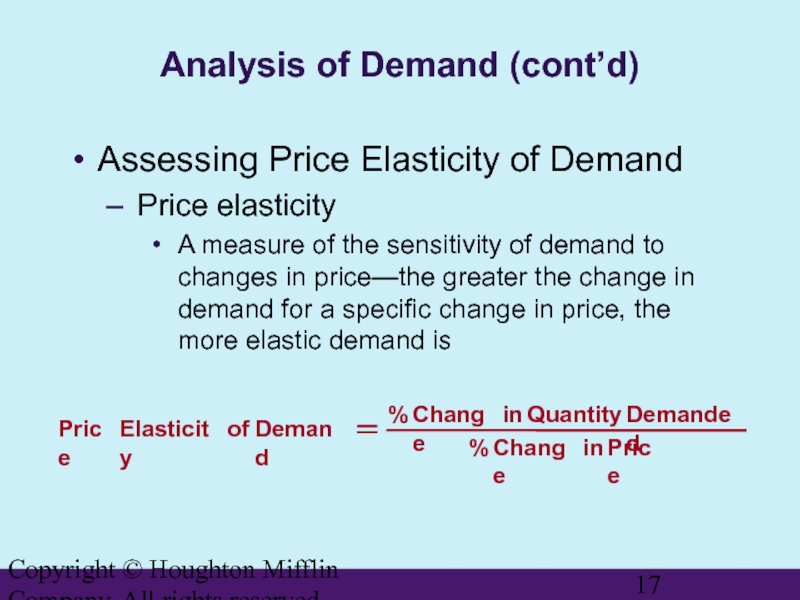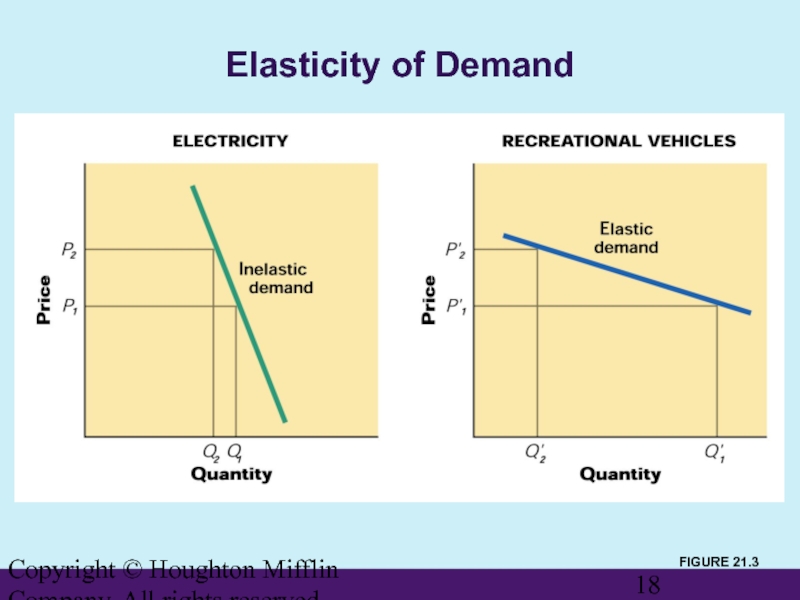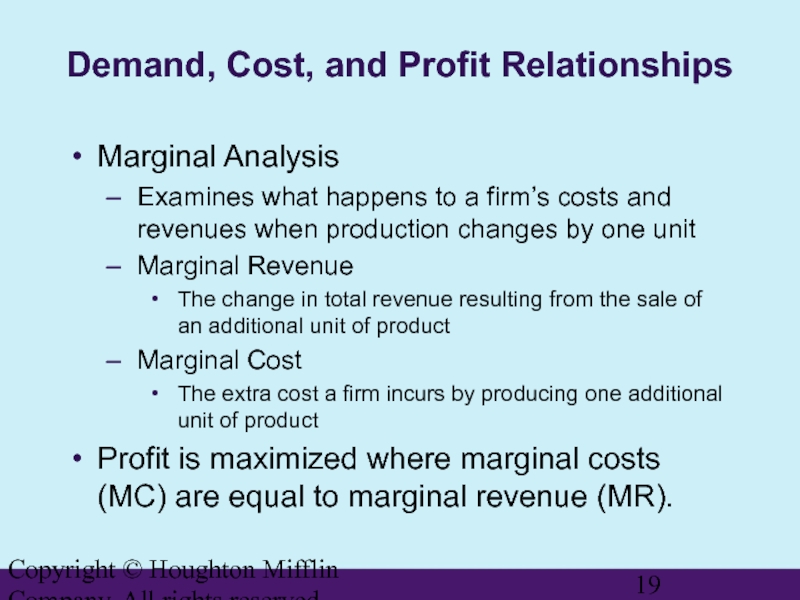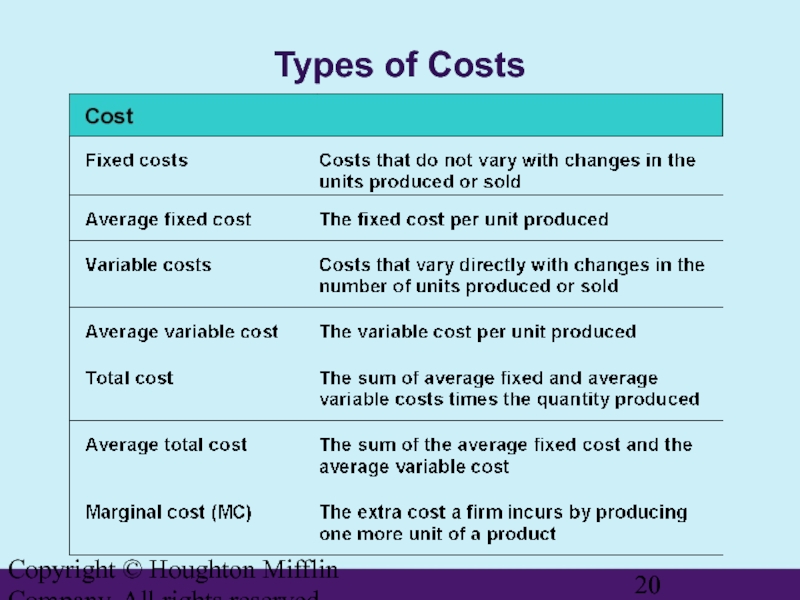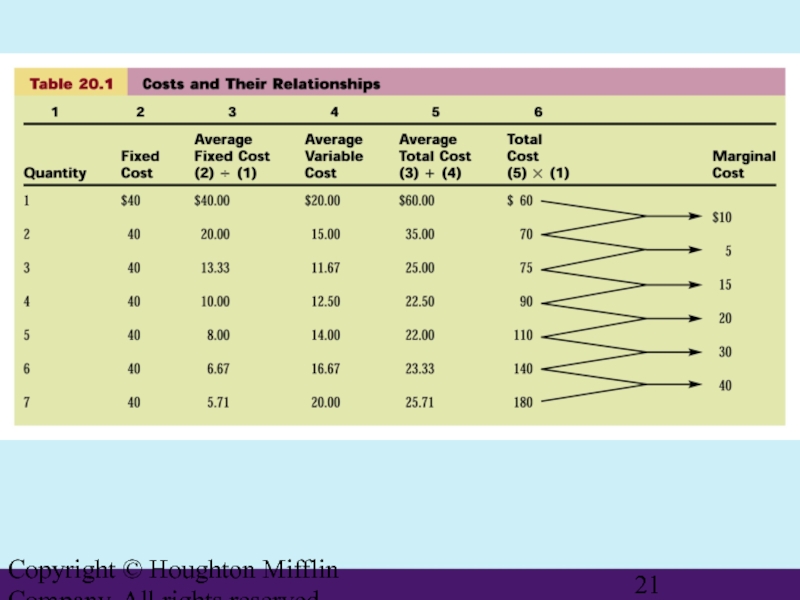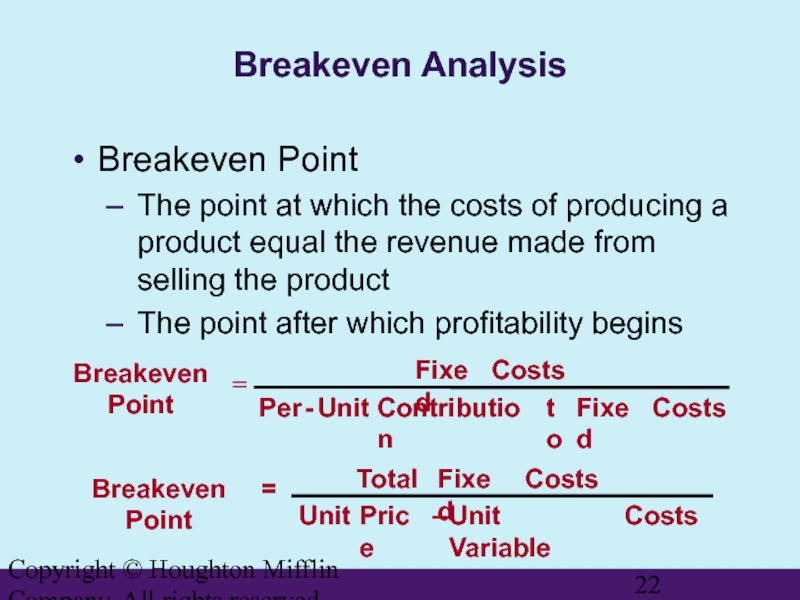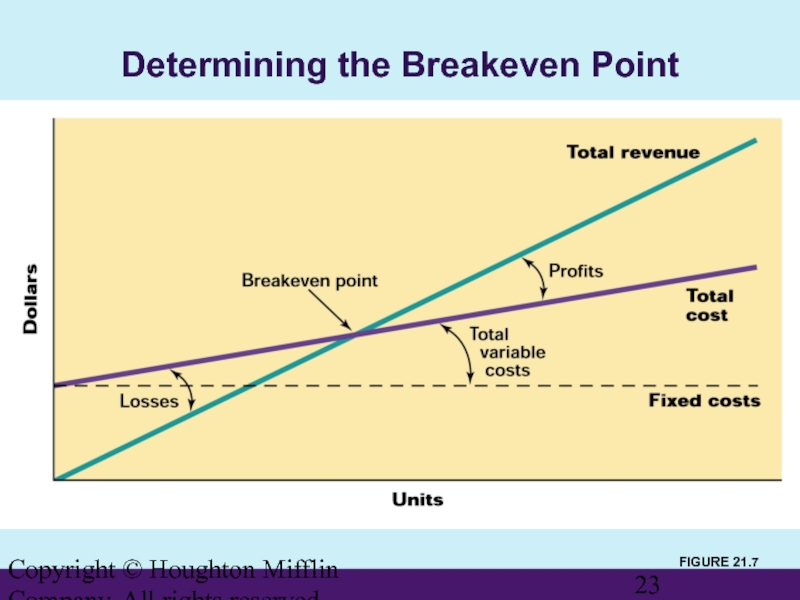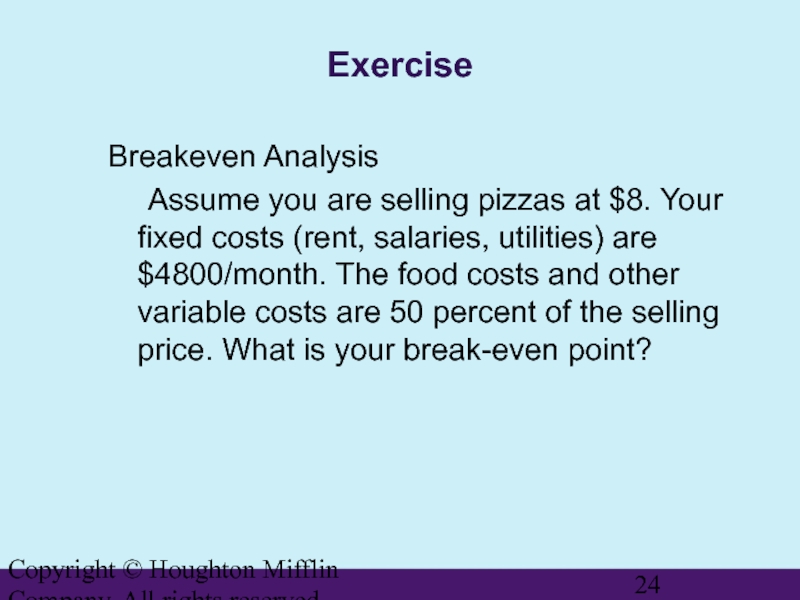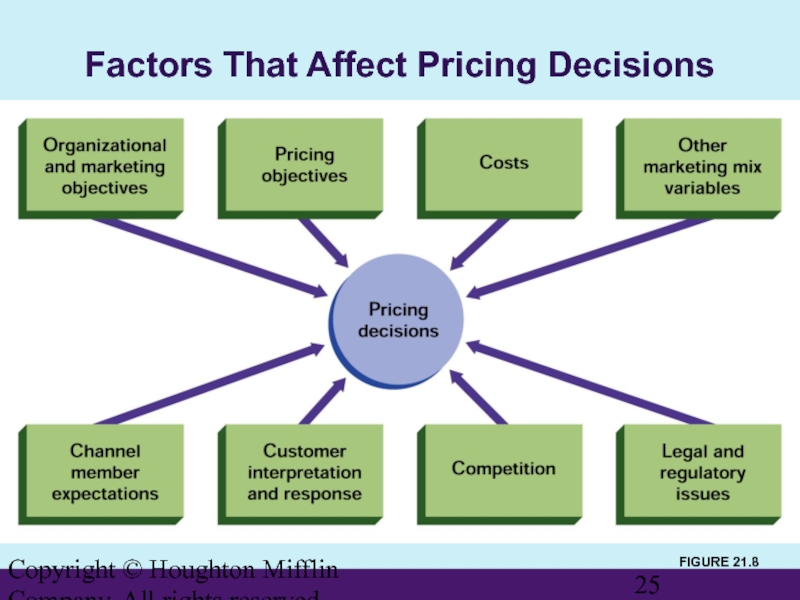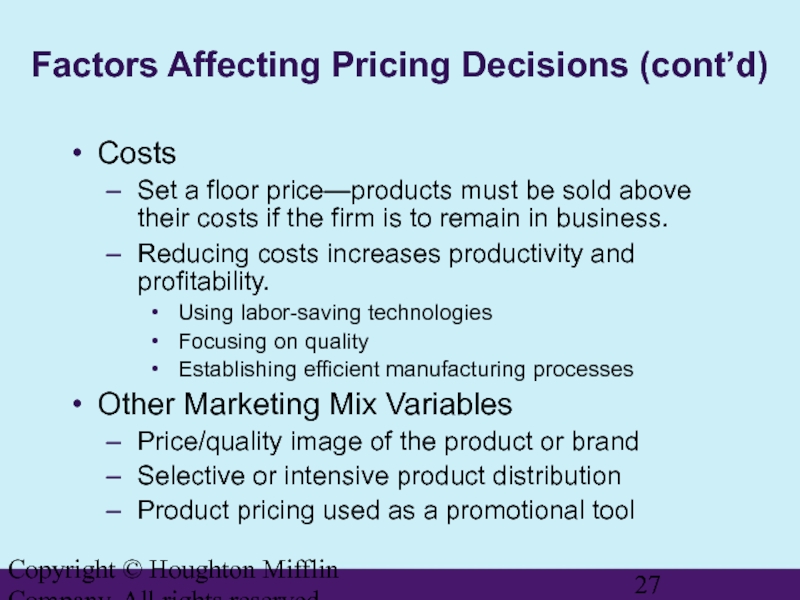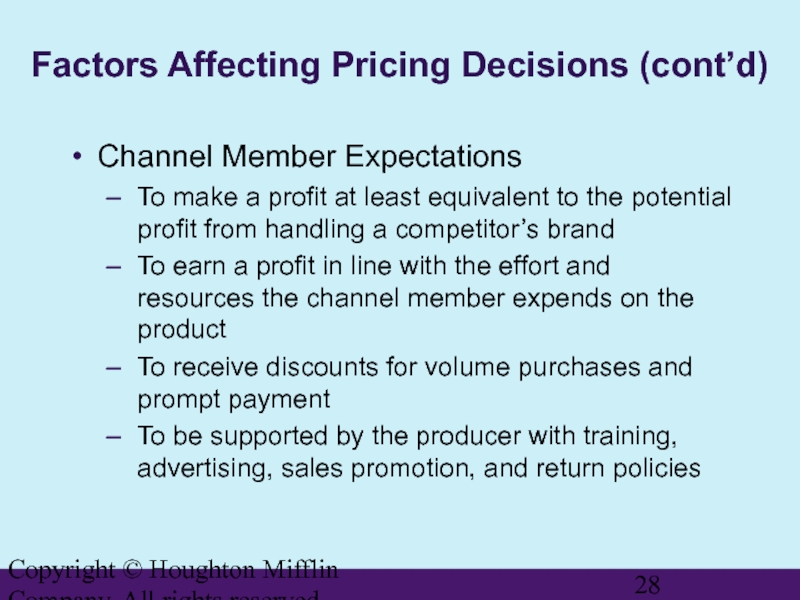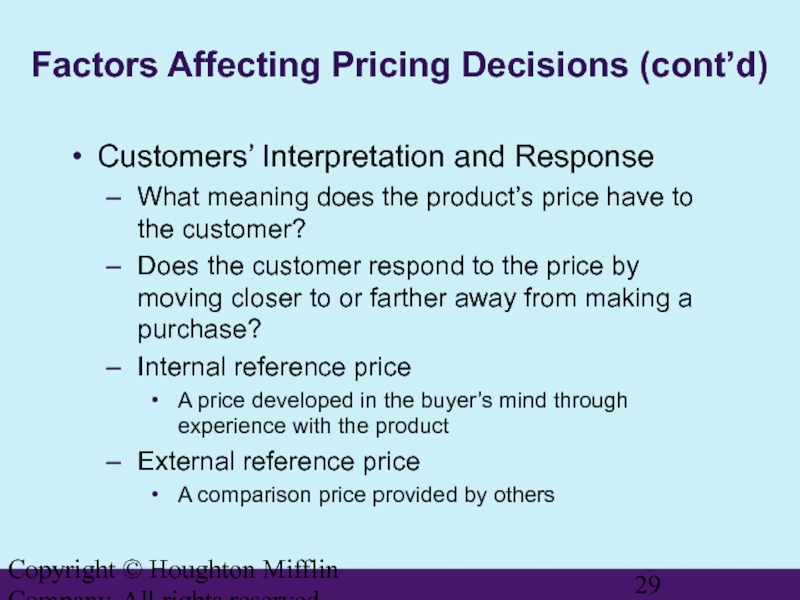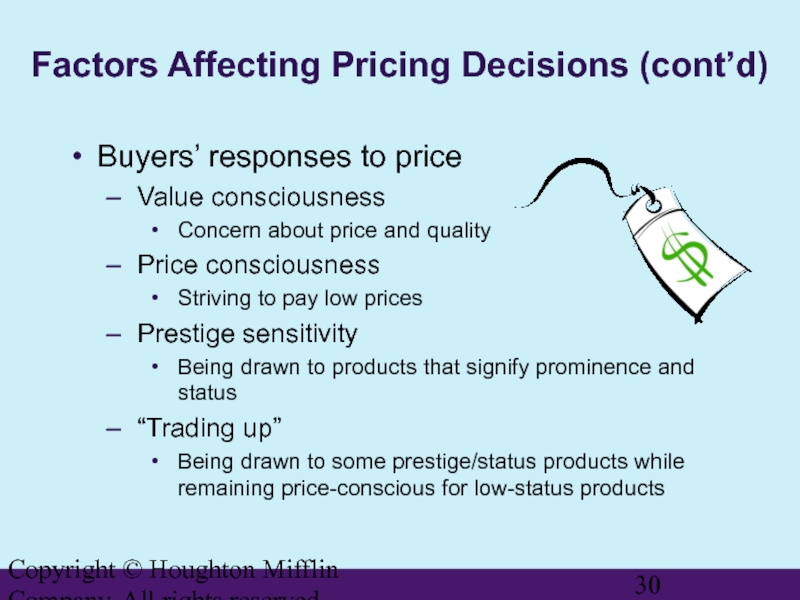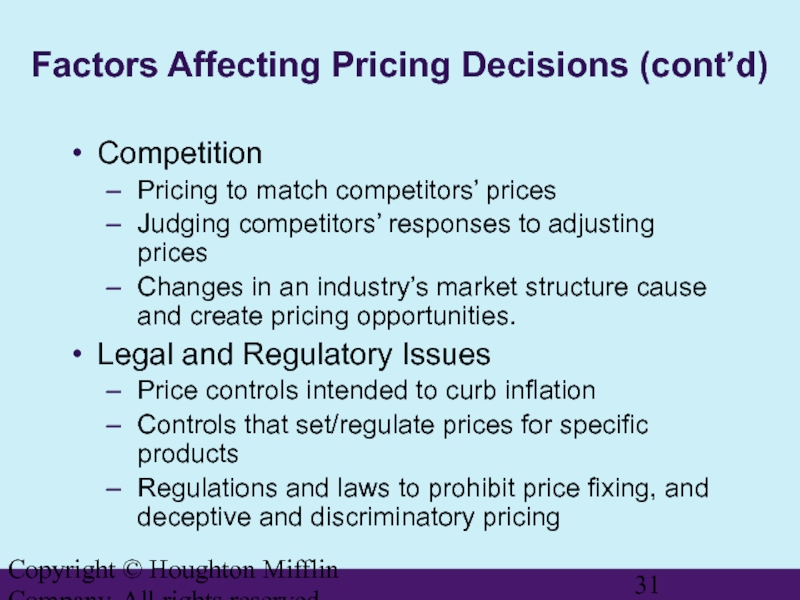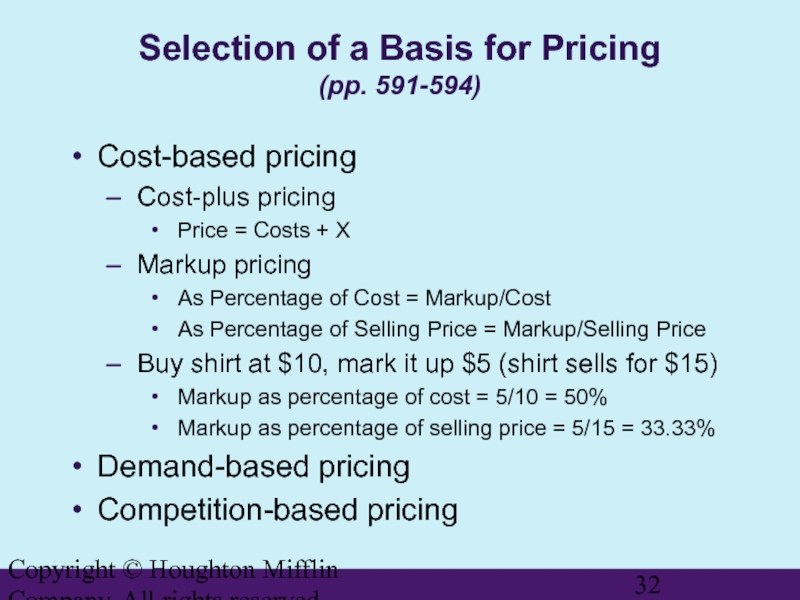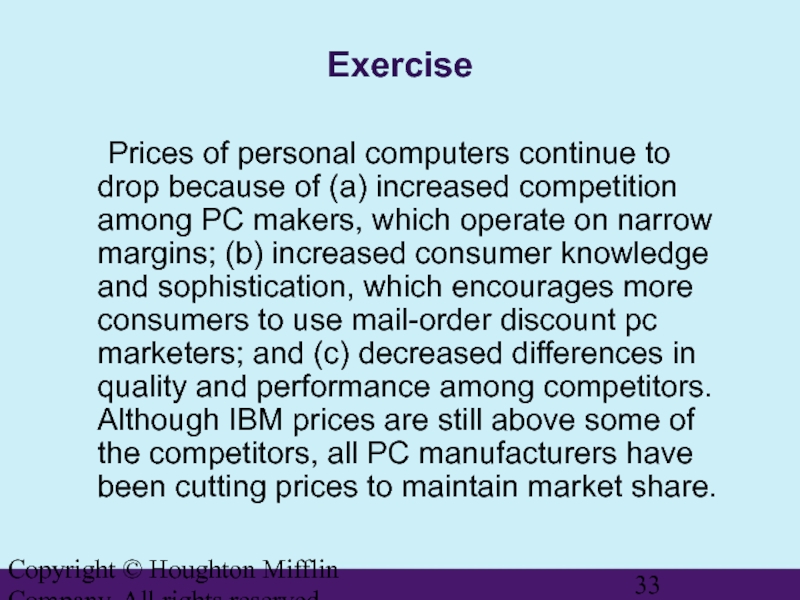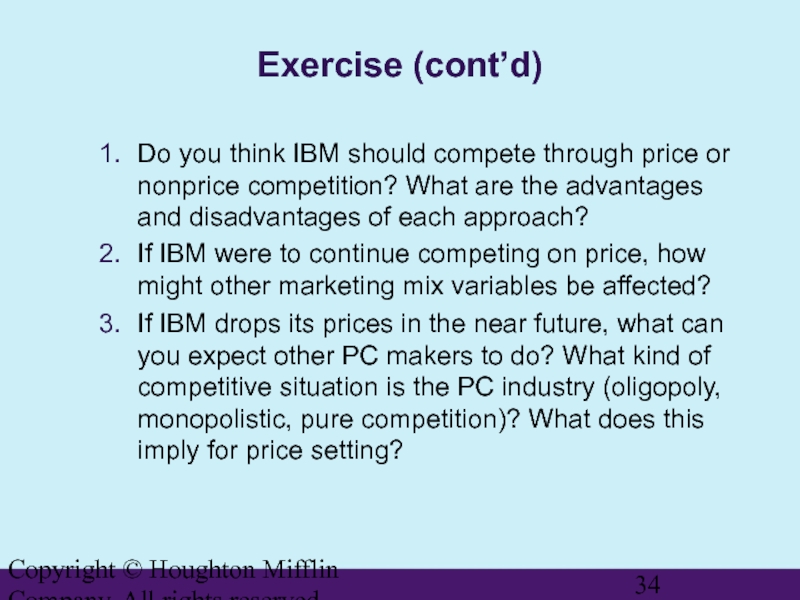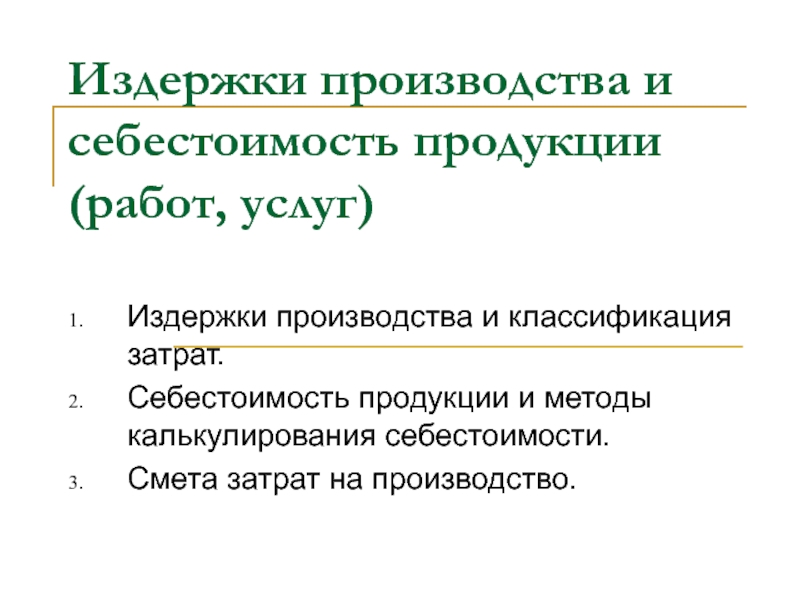- Главная
- Разное
- Дизайн
- Бизнес и предпринимательство
- Аналитика
- Образование
- Развлечения
- Красота и здоровье
- Финансы
- Государство
- Путешествия
- Спорт
- Недвижимость
- Армия
- Графика
- Культурология
- Еда и кулинария
- Лингвистика
- Английский язык
- Астрономия
- Алгебра
- Биология
- География
- Детские презентации
- Информатика
- История
- Литература
- Маркетинг
- Математика
- Медицина
- Менеджмент
- Музыка
- МХК
- Немецкий язык
- ОБЖ
- Обществознание
- Окружающий мир
- Педагогика
- Русский язык
- Технология
- Физика
- Философия
- Химия
- Шаблоны, картинки для презентаций
- Экология
- Экономика
- Юриспруденция
Pricing concepts. The nature of price. Price and nonprice competition. (Chapter 21) презентация
Содержание
- 1. Pricing concepts. The nature of price. Price and nonprice competition. (Chapter 21)
- 2. Copyright © Houghton Mifflin Company. All rights
- 3. Copyright © Houghton Mifflin Company. All rights
- 4. Copyright © Houghton Mifflin Company. All rights
- 5. Copyright © Houghton Mifflin Company. All rights
- 6. Copyright © Houghton Mifflin Company. All rights
- 7. Copyright © Houghton Mifflin Company. All rights
- 8. Copyright © Houghton Mifflin Company. All rights
- 9. Copyright © Houghton Mifflin Company. All rights
- 10. Copyright © Houghton Mifflin Company. All rights reserved. Hertz Emphasizes Its Benefits to Small Businesses
- 11. Copyright © Houghton Mifflin Company. All rights
- 12. Copyright © Houghton Mifflin Company. All rights
- 13. Copyright © Houghton Mifflin Company. All rights
- 14. Copyright © Houghton Mifflin Company. All rights
- 15. Copyright © Houghton Mifflin Company. All rights
- 16. Copyright © Houghton Mifflin Company. All rights
- 17. Copyright © Houghton Mifflin Company. All rights
- 18. Copyright © Houghton Mifflin Company. All rights reserved. Elasticity of Demand FIGURE 21.3
- 19. Copyright © Houghton Mifflin Company. All rights
- 20. Copyright © Houghton Mifflin Company. All rights reserved. Types of Costs
- 21. Copyright © Houghton Mifflin Company. All rights reserved.
- 22. Copyright © Houghton Mifflin Company. All rights
- 23. Copyright © Houghton Mifflin Company. All rights reserved. FIGURE 21.7 Determining the Breakeven Point
- 24. Copyright © Houghton Mifflin Company. All rights
- 25. Copyright © Houghton Mifflin Company. All rights reserved. FIGURE 21.8 Factors That Affect Pricing Decisions
- 26. Copyright © Houghton Mifflin Company. All rights
- 27. Copyright © Houghton Mifflin Company. All rights
- 28. Copyright © Houghton Mifflin Company. All rights
- 29. Copyright © Houghton Mifflin Company. All rights
- 30. Copyright © Houghton Mifflin Company. All rights
- 31. Copyright © Houghton Mifflin Company. All rights
- 32. Copyright © Houghton Mifflin Company. All rights
- 33. Copyright © Houghton Mifflin Company. All rights
- 34. Copyright © Houghton Mifflin Company. All rights
Слайд 2Copyright © Houghton Mifflin Company. All rights reserved.
Agenda
The Nature of Price
Price
Analysis of Demand
Demand, Cost, and Profit Relationships
Factors Affecting Pricing Decisions
Слайд 3Copyright © Houghton Mifflin Company. All rights reserved.
The Nature of Price
Price
The
Barter
The trading of products; the oldest form of exchange
Terms Used to Describe Price
Tuition, premium, fine, fee, fare, toll, rent, commission, dues, deposit, tips, interest, taxes
Слайд 4Copyright © Houghton Mifflin Company. All rights reserved.
The Nature of Price
The Importance of Price to Marketers
The most readily changeable characteristic (under favorable circumstances) of a product.
It relates directly to generation of revenues and quantities sold.
A key component of the profit equation, having strong effect on the firm’s profitability.
Has symbolic value to customers—prestige pricing.
Слайд 5Copyright © Houghton Mifflin Company. All rights reserved.
The Importance of Price-Related
Source: Reprinted with permission from the 20th Annual Survey of Promotional Practices. Copyright © 1998.
Слайд 6Copyright © Houghton Mifflin Company. All rights reserved.
Price and Nonprice Competition
Price
Emphasizing price and matching or beating competitors’ prices
An effective strategy in markets with standardized products
Lowest-cost competitor (seller) will be most profitable.
Allows marketers to respond quickly to competitors
Price wars can weaken competing organizations.
Слайд 7Copyright © Houghton Mifflin Company. All rights reserved.
Price and Nonprice Competition
Nonprice Competition
Emphasizing factors other than price to distinguish a product from competing brands
Distinctive product features
Service
Product quality
Promotion
Packaging
Слайд 8Copyright © Houghton Mifflin Company. All rights reserved.
Price and Nonprice Competition
Nonprice Competition (cont’d)
Advantage is in increasing brand’s unit sales without changing price.
Is effective when a product or service’s features are difficult to imitate by competitors and customers perceive their value
Builds customer loyalty by focusing on nonprice features
Слайд 9Copyright © Houghton Mifflin Company. All rights reserved.
Orbitz Allows People to
Reprinted with permission of Orbitz.
Слайд 10Copyright © Houghton Mifflin Company. All rights reserved.
Hertz Emphasizes Its Benefits
Слайд 11Copyright © Houghton Mifflin Company. All rights reserved.
Exercise:
Price Vs. Nonprice Competition
For
__________ 1. Toyota Hybrid Prius
__________ 2. Hyundai Sonata
__________ 3. Porsche Cayenne SUV
__________ 4. Estee Lauder Electric Intense LipCreme
__________ 5. Avon Brilliant Moisture Lip Color
__________ 6. Louis Vuitton’s Murakami handbags
__________ 7. Olay Complete Moisturizing Lotion
__________ 8. Toshiba widescreen televisions
Слайд 12Copyright © Houghton Mifflin Company. All rights reserved.
Debate Issue
Is price competition
Слайд 13Copyright © Houghton Mifflin Company. All rights reserved.
Analysis of Demand
The Demand
A graph of the quantity of products expected to be sold at various prices
Decreases in price create increases in quantities demanded.
Increased demand means larger quantities sold at the same price.
Prestige items sell best in higher price ranges.
Слайд 14Copyright © Houghton Mifflin Company. All rights reserved.
Demand Curve Illustrating the
FIGURE 21.1
Слайд 15Copyright © Houghton Mifflin Company. All rights reserved.
Demand Curve Illustrating the
FIGURE 21.2
Слайд 16Copyright © Houghton Mifflin Company. All rights reserved.
Analysis of Demand (cont’d)
Demand
Changes in buyers’ needs
Variations in the effectiveness of the marketing mix
The presence of substitutes
Dynamic environmental factors
Слайд 17Copyright © Houghton Mifflin Company. All rights reserved.
Analysis of Demand (cont’d)
Assessing
Price elasticity
A measure of the sensitivity of demand to changes in price—the greater the change in demand for a specific change in price, the more elastic demand is
Слайд 19Copyright © Houghton Mifflin Company. All rights reserved.
Demand, Cost, and Profit
Marginal Analysis
Examines what happens to a firm’s costs and revenues when production changes by one unit
Marginal Revenue
The change in total revenue resulting from the sale of an additional unit of product
Marginal Cost
The extra cost a firm incurs by producing one additional unit of product
Profit is maximized where marginal costs (MC) are equal to marginal revenue (MR).
Слайд 22Copyright © Houghton Mifflin Company. All rights reserved.
Breakeven Analysis
Breakeven Point
The
The point after which profitability begins
Слайд 23Copyright © Houghton Mifflin Company. All rights reserved.
FIGURE 21.7
Determining the Breakeven
Слайд 24Copyright © Houghton Mifflin Company. All rights reserved.
Exercise
Breakeven Analysis
Assume you are
Слайд 25Copyright © Houghton Mifflin Company. All rights reserved.
FIGURE 21.8
Factors That Affect
Слайд 26Copyright © Houghton Mifflin Company. All rights reserved.
Factors Affecting Pricing Decisions
Organizational
Prices should be set that are consistent with the organization’s goals and mission.
Prices must be compatible with marketing objectives (e.g., setting premium prices to enhance a product’s quality image).
Types of Pricing Objectives
Setting prices low to increase market share
Using temporary price reductions to gain market share
Lowering prices to raise cash quickly
Слайд 27Copyright © Houghton Mifflin Company. All rights reserved.
Factors Affecting Pricing Decisions
Costs
Set a floor price—products must be sold above their costs if the firm is to remain in business.
Reducing costs increases productivity and profitability.
Using labor-saving technologies
Focusing on quality
Establishing efficient manufacturing processes
Other Marketing Mix Variables
Price/quality image of the product or brand
Selective or intensive product distribution
Product pricing used as a promotional tool
Слайд 28Copyright © Houghton Mifflin Company. All rights reserved.
Factors Affecting Pricing Decisions
Channel Member Expectations
To make a profit at least equivalent to the potential profit from handling a competitor’s brand
To earn a profit in line with the effort and resources the channel member expends on the product
To receive discounts for volume purchases and prompt payment
To be supported by the producer with training, advertising, sales promotion, and return policies
Слайд 29Copyright © Houghton Mifflin Company. All rights reserved.
Factors Affecting Pricing Decisions
Customers’ Interpretation and Response
What meaning does the product’s price have to the customer?
Does the customer respond to the price by moving closer to or farther away from making a purchase?
Internal reference price
A price developed in the buyer’s mind through experience with the product
External reference price
A comparison price provided by others
Слайд 30Copyright © Houghton Mifflin Company. All rights reserved.
Factors Affecting Pricing Decisions
Buyers’ responses to price
Value consciousness
Concern about price and quality
Price consciousness
Striving to pay low prices
Prestige sensitivity
Being drawn to products that signify prominence and status
“Trading up”
Being drawn to some prestige/status products while remaining price-conscious for low-status products
Слайд 31Copyright © Houghton Mifflin Company. All rights reserved.
Factors Affecting Pricing Decisions
Competition
Pricing to match competitors’ prices
Judging competitors’ responses to adjusting prices
Changes in an industry’s market structure cause and create pricing opportunities.
Legal and Regulatory Issues
Price controls intended to curb inflation
Controls that set/regulate prices for specific products
Regulations and laws to prohibit price fixing, and deceptive and discriminatory pricing
Слайд 32Copyright © Houghton Mifflin Company. All rights reserved.
Selection of a Basis
Cost-based pricing
Cost-plus pricing
Price = Costs + X
Markup pricing
As Percentage of Cost = Markup/Cost
As Percentage of Selling Price = Markup/Selling Price
Buy shirt at $10, mark it up $5 (shirt sells for $15)
Markup as percentage of cost = 5/10 = 50%
Markup as percentage of selling price = 5/15 = 33.33%
Demand-based pricing
Competition-based pricing
Слайд 33Copyright © Houghton Mifflin Company. All rights reserved.
Exercise
Prices of personal computers
Слайд 34Copyright © Houghton Mifflin Company. All rights reserved.
Exercise (cont’d)
Do you think
If IBM were to continue competing on price, how might other marketing mix variables be affected?
If IBM drops its prices in the near future, what can you expect other PC makers to do? What kind of competitive situation is the PC industry (oligopoly, monopolistic, pure competition)? What does this imply for price setting?
